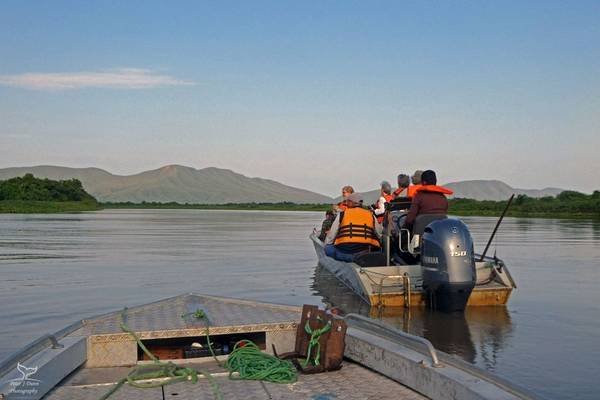Wildlife Holidays in the Pantanal




The Pantanal is a truly remarkable place to experience nature. The world’s largest tropical wetland (its name literally means ‘big marsh’), it covers a vast 70,000 square miles, mostly in Brazil but spreading into neighbouring Paraguay and Bolivia. Although it is perhaps less well-known than the Amazon rainforest, it actually contains some of the highest concentrations of wildlife in all the Americas. As many of its habitats are much more open than the jungles to the north, the Pantanal provides far better opportunities to observe an astonishing diversity of species. This breathtaking wilderness is the best place in the world to see the mighty Jaguar, while other mammals include Brazilian Tapir, Giant River Otter and Capybara – these, and many more, live alongside an estimated 10 million Yacare Caimans, and a profusion of birdlife that must be seen to be believed. Nowhere else in the Western Hemisphere can a visitor view the natural world in such riotous abundance.
Speak with our the Pantanal specialist

Specialist Recommends
"Our 'Brazil – Just Jaguars!' holiday is a spectacular way to spend 12 days in Brazil. Jaguars are the obvious highlight but there are many others, including Hyacinth Macaws, Toco Toucans and Giant Otters. We visit a hide for Ocelot and Tapir, go out spotlighting for Giant Anteater and explore the Pantanal by foot, boat and safari vehicle. So it is of course far more than 'Just Jaguars'! Each of our holiday offerings is carefully crafted, each one a superb experience and jam packed with wildlife encounters that will live long in the memory."
Operations Manager - Tom MabbettWildlife in the Pantanal
Contained primarily within the Brazilian states of Mato Grosso do Sul and Mato Grosso, the Pantanal consists of a gigantic sedimentary basin, surrounded by areas of higher ground. The area is dominated by the Paraguay River and its tributaries – during the rainy season (from December to March) these rivers back up and burst their banks, flooding 80% of the landscape and forming myriad marshes, swamps and shallow lakes. The floodwaters also give the Pantanal’s soil enormous fertility, supporting a vibrant community of plants. At this time of year, just a few islands of dry ground remain, but it is in fact during the dry season that wildlife-viewing is at its most spectacular. As the waters recede, many kinds of creatures are drawn to the shrinking pools, often in concentrations that are scarcely imaginable.
Much of the exploration of the Pantanal takes place along the famous Transpantaneira, the only road to penetrate deep into the wetland’s wild heart. Over 100 miles in length, and crossing some 120 bridges along the way, this causeway passes through open savannahs and wetlands, where a roadside abundance of wildlife can be expected. As a visitor travels down the Transpantaneira, some of the most obvious species will inevitably include numerous Capybara (the world’s largest rodent), Yacare Caiman, Marsh Deer, and a bewildering assortment of birds, from Roadside Hawks to Southern Screamers and Crested Caracaras.
Closer to the start of the road, before reaching the true watery core of the Pantanal, one passes through an area of ranchland. Most human activity is set back from the road and is not immediately obvious to passers-by, but still, this is one of Brazil’s most important beef-producing regions. Nevertheless, many of these ranches are fantastic places for wildlife, offering a chance to see species that are less suited to true wetland habitats. Some of the mammals that can be found here include Azara’s Agouti, Black-tailed Marmoset, Black-capped Capuchin Monkey and Southern Tamandua, with a chance of the latter’s extraordinary large relative, the Giant Anteater. These bizarre creatures can weigh up to 50 kilograms and travel great distances in search of their ant and termite prey. Although they are occasionally active during the day, most feeding takes place after dark – some lodges offer night drives, providing an excellent opportunity to encounter them and a host of other elusive nocturnal species. Regularly seen, in the right locations, are Brazilian Tapir, Ocelot, Brown Brocket Deer, Crab-eating Fox and even Puma.
The ranches also provide remarkable opportunities for birding. One of the most sought-after species is the stunning Hyacinth Macaw, the world’s largest flying parrot (only New Zealand’s flightless Kakapo weighs more). At up to a metre in length, it dwarfs most of its other relatives. This is a bird that has been hit hard by habitat loss and trapping for the pet trade, and the Pantanal is certainly its greatest remaining stronghold. Happily, many of the lodges in this area have resident breeding Hyacinth Macaws, and finding them is usually quite straightforward. Another avian icon of the Pantanal is the huge Jabiru Stork, the tallest flying bird in the American tropics – the biggest males can stand over a metre-and-a-half high. The drier landscapes of the Pantanal are dotted with their great tree-platform nests. Other special birds here include Rufescent Tiger, Striated, Cocoi and Whistling Herons, Roseate Spoonbill, Limpkin, Greater Rhea and some brilliant hummingbirds.
The Transpantaneira finally ends in the small village of Porto Jofre, on the Cuiaba River. Here, you must either turn around, or take to the water! This is the starting point for quests in search of the Pantanal’s most magnificent and sought-after resident, the Jaguar. These wetlands host the greatest known concentrations of the Americas’ largest cat – they exist here at densities double those recorded anywhere else. This is partly due to an abundance of food – Jaguars in the Pantanal have an unusually aquatic diet, regularly hunting caimans and relying heavily on fish. Living amidst such a bounty seems also to have made them less territorial than they are elsewhere; these Jaguars share home ranges, and are often seen moving, hunting and even playing together.
Luckily for visitors, this all makes the Pantanal by far the best place in the world to see Jaguars. Cruising the quiet waterways around Porto Jofre (close to the excellent ‘Jaguar Flotel’ – a floating hotel in the heart of Jaguar country) is practically guaranteed to produce multiple sightings, often of very relaxed individuals. Another scarce mammal that is easily found here is the amazing Giant Otter, whose Brazilian name actually translates as ‘water Jaguar’. These animals – the longest members of the weasel family – can reach 1.7 metres in length and weigh 30 kilograms. They are also amongst the most social and vocal otter species, with a variety of distinct calls – for alarm, aggression and social cues – having been recorded. At dusk, visitors are treated to the spectacle of many thousands of Greater and Lesser Bulldog Bats hunting over the waters. Here too the birdlife is superb. Toco Toucan, the cryptic Great Potoo, Agami Heron, Sunbittern and all five of South America’s kingfisher species – Ringed, Amazon, Green, Green-and-rufous and Pygmy – can be found.
For those looking for an opportunity to explore the very wildest recesses of the Pantanal, it is also possible to take a liveaboard boat far beyond the usual tourist hotspots. The ultimate destination is the remote Pantanal National Park, a little-visited place where otherworldly Giant Waterlilies grow beneath towering granite peaks. Many of the species found here are similar to those elsewhere in the Pantanal, but here they can be enjoyed in absolute peace and solitude.
Overall, the Pantanal is surely South America’s most rewarding wildlife destination. With over 150 species of mammal and some 600 species of bird, many of which are highly visible and charismatic, there is nowhere better to experience this continent’s natural wonders.



 Loading search...
Loading search...









